Probably the best place to go is right where the main uprising/massacre took place - The former Kaohsiung City Hall, which happens to be the Kaohsiung Museum of History now.
They have a pretty good permanent exhibit dedicated to 228.
Probably the best place to go is right where the main uprising/massacre took place - The former Kaohsiung City Hall, which happens to be the Kaohsiung Museum of History now.
They have a pretty good permanent exhibit dedicated to 228.
Perhaps you’ve already seen these posts while combing through the links, but I think these would offer a more complete picture of what happened.
The two links above talk about the ordeals that Tsiúnn Ūi-tshuan (蔣渭川) and his daughter had to go through.
Chen Yi enlisted Taiwanese elites who were KMT members to urge the public to stay calm over the radio on March 2 1947, and then sent troops after these elites on March 10 when reinforcement from China arrived. Tsiúnn was the brother of the famous Japanese era Taiwanese self-governance advocate Tsiúnn Ūi-suí (蔣渭水). Immediately after making the broadcast as Chen Yi requested, Tsiúnn Ūi-tshuan also secretly asked for the Americans to deliver a message to CKS, begging him not send additional troops to Taiwan.
INCOMING TELEGRAM
RESTRICTED
Control 2292
Rec’d March 8, 1947
1:12 a.m.FROM: Nanking
TO: Secretary of State
NO: 479, March 7, 4 p.m.Following is 36 Mar 5 from Taipei.
"Following is translated text of letter handed to Consulate today by delegation of Political Reconstruction Promotion Assn of Taiwan, an established responsible organization, taking large part in mediation for settlement of present situation.
'March 5, 1947.
'The US Consulate Taipei Taiwan
'Sir:'For the protection of the lives of the six million and more Formosans, we cordially request you to forward the enclosed letter to Ambassador Dr. Leighton Stuart for transmission to the National Govt of the Republic of China.
‘From (chopped) the Political Reconstruction Promotion Assn of Taiwan’
Following is translated text of enclosure : 'To His Excellency, President Chiang of the National Govt of the Republic of China through the kindness of Ambassador Dr. Leighton Stuart of the American Embassy in Nanking:
'Your Excellency:
'This civil commotion in Taiwan Province is purely in protest against corrupt officialdom and a demand for political reformation with no other purposes whatsoever. We entreat you
not to dispatch troops to Taiwan in order to avoid further provocation of the people. We also earnestly beg that you immediately send a high official to Taiwan to settle the incident for the sake of the nation.
‘From (chopped) the Political Reconstruction Promotion Assn of Taiwan Province. March 5’
“Consulate has agreed to forward this communication to American Embassy for its discretionary action”.
STUART
JMS:ABC
A Youth League of considerable potential significance came into being. Stressing …
as basic principles a desire to make Taiwan a model province of China and to …
hasten Dr. Sun Yat-sen’s program of National Reconstruction. The founder, …
former president of the Chamber of Commerce, Chiang We-chuan, said:
“We absolutely support the Central Government but will eradicate all currupt officials in this province. This is our aim which I hope every one of you fully grasp.” (Ching Wei Jih Pao, March 6, 1947)
Despite the Americans delivering that message, CKS sent troops anyway. Five days after Tsiúnn made his broadcast, Chen Yi sent soldiers to his house in an attempt to capture and execute him. Tsiúnn managed to escape alone, but his daughter Tsiúnn Kháu-hûn (蔣巧雲) was killed on site. His son Tsiúnn Siông-pîng (蔣松平) was mortally wounded. After hiding for an entire year, Tsiúnn only re-emerged after Qiu Nian-tai (丘念台, son of Qiu Feng-jia 丘逢甲) guaranteed his safety.
I also wrote about Walis Wumi, who was an anti-Japanese Truku and celebrated the KMT’s arrival. He became the first KMT appointed head of Xiolin (秀林) rural townships in Hualian. Walis’ grandson Nanan Dadaw have always been told that his grandfather committed suicide by hanging himself. Nanan grew up and became a pastor, and one day his uncle came to ask for his assistance to gain access to the 228 national archive, that’s when Nanan realized that his grandfather was a victim of the 228 incident. His uncle saw Walis Wumi dragged away from KMT troops onto a vehicle when he was 5, and never saw his father again. The 228 national archive provided solid proof that Walis Wumi was indeed a victim of CKS’ Village Clearing (清鄉) operation.
Other Aboriginal leaders around Taiwan who died as a result of 228:
During the 228 incident, Tsou leaders Uyongʉ’e Yatauyungana and Yapasuyongʉ Yulunana formed Aboriginal militias that cooperated with Han militias to maintain peace in Jiayi city, and blockade Shuishang airport. They were both killed by the KMT during the subsequent White Terror era.
Even aboriginals who had nothing to do with armed militias during 228 were killed by the KMT during the White Terror era. The most famous is Altayal Medical Doctor Losing Watan, who was a member in the Provincial parliament. Others like Truku leader Walis Wumi who was adamantly against Japanese rule and celebrated the arrival of KMT was also killed by the KMT.
I think I wrote about other victims, but it would take time for me to dredge them out.
I thought I might have written about this victim, but I can’t find it anywhere…


Zhong Cid-long (張七郎) was a Hakka born in present day Hukou, Hsinchu County. His father was a doctor of traditional medicine, and was one of the first Taiwanese Hakka to convert to Presbyterianism. Due to the influence of his father, the Zhongs became a family of medical doctors. Zhong and his brothers all became doctors, some followed their fathers foot steps, but Zhong Cid-long attended the medical school of the Taiwan Government-General University, which was the predecessor of today’s National Taiwan University College of Medicine, and became a doctor of western medicine.
After graduation, Zhong worked at the Keelung hospital, and the George Leslie Mackay memorial hospital in Tamsui. He became close friends with Mackay’s son George William Mackay, and Zhong became one of the founders of the Tamsui middle school (present day Tamkang high school). He later started his own Rhin-shiu clinic (仁壽醫院) in Tamsui, and relocated his clinic to Fonglin village in Hualien when his brother practicing traditional medicine there told him about the lack of medical resources in Hualien.
Zhong was vehemently anti-Japanese, and forbade speaking Japanese in his home. He was overjoyed when he learned that the KMT was taking over Taiwan when the war ended. He donated money to build a brick arch celebrating Chinese takeover of Taiwan, with the words of SYS, The World is for the Public (天下為公), and The State is of the People (國為民有) written on it.
He also wrote to his three sons practicing medicine in Manchuria, telling them to return to Taiwan. One of his sons, Zhong Rhi-Rhin (張依仁) is said to have treated CKS for diarrhea, and received a ROC medic badge, however, it is hard to verify this claim. I’m not sure if CKS visited Manchuria immediately after the war ended.
Zhong was elected Hualien county councilor in 1946, and became the council speaker. He soon became disillusioned with the KMT occupation. On April 1 1946, Zhong write in his diary “The dogs are gone, but the pigs came in their place. The promise for investment in Taiwan’s infrastructure rings hollow. (犬去豕來,台灣建設徒聽空音)”
In November of 1946, Zhong was elected as Taiwan’s representative to the National Constituent Assembly, and participated in the making of the ROC constitution.
In 1947, Zhong was preparing to run for Hualien county magistrate when 228 happened. He was invited to Hualien’s Settlement Committee for 228 Incident, but Zhong was too ill to participate. By early March, friends informed Zhong and his songs that they were likely on the KMT kill list and it’s best that they went into hiding, but Zhong felt that he had done nothing wrong, and decided to ignore the warning.
By April 1 1947, KMT troops arrived in Fonglin village. The villagers prepared a feast for the troops on April 4, Zhong was still too ill to attend the party, and sent his eldest son, Doctor Zhong Zung-rhin (張宗仁) instead. Not long after Dr. Zhong Zung-rhin returned from the party, a couple soldiers came to the clinic, claiming that several soldiers had food poisoning and needed medical attention. Dr. Zhong Zung-rhin immediately returned to the camp with them to treat the patients, but it was only a ploy to lure him into a trap. Zung-rhin never returned home after that.
By 8 PM that same day, KMT soldiers again came to the clinic again, this time asking to see Zhong’s third son Zhong Go-rhin (張果仁). When Dr. Zhong Go-rhin answered, the soldiers immediately tied his hands behind his back and took him away. Around the same time, soldiers also went to Zhong’s family home to arrest Dr. Zhong Cid-long. His second son Zhong Rhi-Rhin tried to make a run for it, but was captured as well.
Next morning, Dr. Zhong Cid-long’s wife Zham Gim-gi (詹金枝) had his daughter in law bring 4 meal boxes to the camp, but the guards only took one box and returned the rest. That’s when the family started to look for bodies of their loved ones. After searching for an entire day, they found the bodies of Dr. Zhong Cid-long, Dr. Zhong Zung-rhin, and Dr. Zhong Go-rhin in the cemetery. Their bodies were left out in the open, with their hands tied to their backs, stripped down to their underwear, and all their belongings taken.
Dr. Zhong Cid-long had multiple bruises and shot twice in the back, with the bullets going through his chest. Dr. Zhong Zung-rhin had his face cut with a knife, fractured right wrist, and also shot twice in the back. Dr. Zhong Go-rhin was bayoneted in his stomach, with his intestines hanging out of the wound, and also shot twice in the back.
The family quietly moved their bodies back to the family home in the middle of the night. Dr. Zhong Cid-long’s wife, Zham Gim-gi, was a trained nurse, and she put her son’s intestines back into the cavity and stitched up his wound. Her daughter in-laws cleaned up the bodies for the burial. Go-rhin’s wife was pregnant at the time. Zham made repeated appeals to multiple government agencies, but only got a response from the Taiwan Garrison Command, claiming that the 3 executed Zhongs were charged with sedition, planning assassinations, and were killed for resisting arrest.
Dr. Zhong Rhi-Rhin was released 3-month later, and some claimed that his ROC medic badge saved him from an execution. Although, like mentioned before, this is hard to verify. Despite surviving the ordeal, the KMT agents never left him alone, and the constant surveillance forced him to leave Taiwan as a stowaway in 1963 and tried to start over in Brazil. The KMT representatives in Brazil tried to have Brazil arrest him and Rhi-ren had to go deeper into hiding. In 1982 when his mother passed away, Dr. Zhong Rhi-ren was denied entry to Taiwan, and wasn’t able to attend her funeral. Dr. Zhong Rhi-ren wasn’t able to return to Taiwan until 2004, after CSB became president. He passed away in Taichung in 2011 at the age of 92.
Two other Constituent representatives of Taiwan were also hunted down after the 228 incident. Lîm Liân-tsong (林連宗) was killed, and Gân Khim-hiân (顏欽賢) escaped arrest and hid until he was pardoned.
The takeaway from these terrible events is that the 228 Incident encompassed random state violence and terror (seen, for example, with incoming ROC soldiers shooting indiscriminately at people after landing at Keelung) to a more systematic attempt to target and kill Taiwan’s elites. The use of state force to target elites and intellectuals (including Taiwanese American returnees such as Chen Wen-chen) continued until the 1980s.
Guy
There used to be a fair-sized cache of documents on the Internet relating to that period, but I think it ceased to be available at the URL(s) where it was originally located. There were images of letters from some of the people who were active back in the latter half of the 1940s, and there were images of other kinds of documents.
Just now, I was tinkering on what appears to be a subsite of the Ministry of Culture’s site, called the Taiwan Cultural Memory Bank. I typed in the search terms “george f kerr” (I should have typed “george h kerr,”) in quotes in a search box, and I got images of some letters between Mr. Kerr and others. Here’s the link to that page (I hope this works):
It seems to take a while to load, and for all I know, it might take some tinkering (edited to add, I don’t think my tinkering helped; I think the page just took a while to load–it’s got a lot of stuff on it).
I can’t read Chinese, but I’m a using a Chrome browser, which often activates Google Translate if one right-clicks it on the page.
Edited to add, just as a sample, a summary of Chen Yi’s speech of March 10 (in English):
The Futai Street Mansion was the home of the People’s Advocate newspaper, which was shut down in 1947. Its founder and its editor-in-chief reportedly disappeared.
I got that here (in English):
Adding one more, " Summary of Wang Tien-Tingʹs Speech through the UXRA at 5:35 p.m. March 2, 1947" (in English; I don’t know what “UXRA” stands for; Wang Tien-ting was the name of the editor-in-chief of the People’s Advocate newspaper):
Now I’m going to the breakfast shop.
you guys have really come through… This is exactly what I was looking for despite the inevitable friction such a reflection on this period invites. Thanks all!
Is there any description of how organised the local 228 committees were, as in how networked were they? Did they have any national leaders etc?
My understanding is more that local politicians and elites took over govnernance in an ad hoc fashion until the KMT violently wrested back control?
As the anniversary of the February 28 Incident approaches, Sean Lin writing at Focus Taiwan has put out an impressively rich and detailed look at how the families of survivors are thinking about the current state of transitional justice, and—through the views of Wu Rwei-ren at Academia Sinica—some of the many challenges that remain.
Since Focus Taiwan now paywalls their stories (stupidly, in my view) after a certain number of months have passed, I’ll place the whole story below the line to archive it, as this could be of interest to forumosans in the future, as they look back at 2024 . . .
02/26/2024 03:51 PM
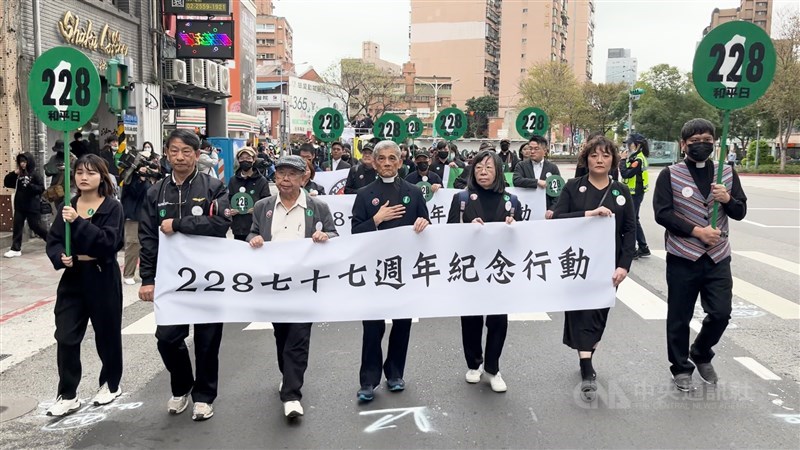
Members of civic groups march on the streets of Taipei to demand that the government step up its efforts to push for transitional justice on Feb. 24. CNA photo Feb. 26, 2024
By Sean Lin, CNA staff reporter
Members of civic groups took to the streets to call on the government to step up its efforts to bring transitional justice days before the 77th anniversary of the 228 Incident.
Among their appeals, none resonated more powerfully with families of victims than a call to remove a towering statue of Chiang Kai-shek that has sat in downtown Taipei for over four decades.
In an interview with CNA, Peter Pan (潘信行), whose father was executed by the then-Kuomintang (KMT) government during the incident, said efforts to achieve transitional justice by Taiwan’s current Democratic Progressive Party (DPP) government are still lacking.
The 228 Incident was an anti-KMT government uprising in 1947 that resulted in a brutal crackdown, which left tens of thousands of people, many of them Taiwanese intellectuals and elites, dead or imprisoned.
Pan’s father, Pan Mu-chih (潘木枝), conducted negotiations with KMT troops on behalf of Chiayi’s 228 Settlement Committee.
However, the city councilor was detained during the talks and executed in front of Chiayi Railway Station on March 25, 1947.
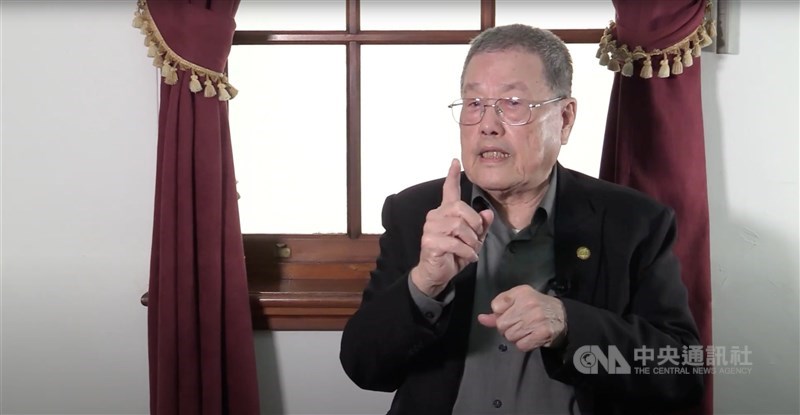
Peter Pan, son of 228 victim Pan Mu-chih. CNA photo Feb. 26, 2024
“All evidence indicates that Chiang Kai-shek was responsible for 228, but his giant statue is still housed in a memorial hall - that’s just rubbing it in for us family members,” said Pan.
According to Pan, allowing the statue and the Chiang Kai-shek Memorial Hall to remain means that the DPP has “only done half a good deed.”
Citing Spain’s exhumation of dictator Francisco Franco’s remains from the Valle de los Caídos (Valley of the Fallen) state mausoleum in 2019 following a vote by the country’s Congress of Deputies, Pan said Taiwan should approach the matter of Chiang’s statue through legislation.
As for the memorial hall, Pan said it should be renamed and given back to the people, who funded its construction with their tax payments.
Lin Li-tsai (林黎彩), whose father Lin Chieh (林界) was also executed during the 228 incident, said that as long as Chiang’s statue remains, “there will never be transitional justice.”
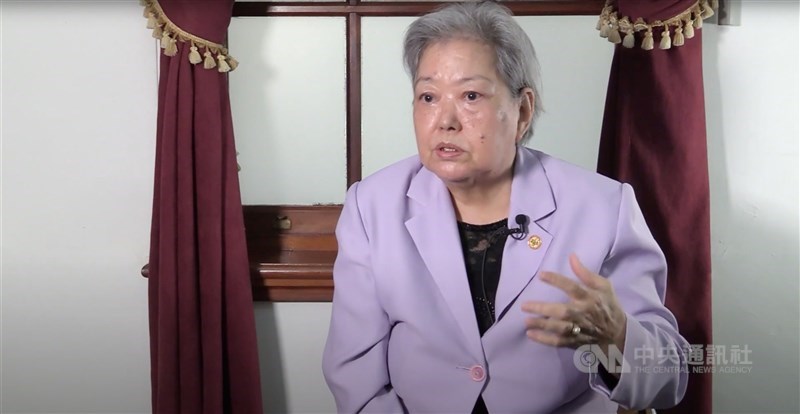
Lin Li-tsai, daughter of 228 victim Lin Chieh
Lin said removing the Chiang statue at the memorial hall would be the “most meaningful thing” the government could do for the families of 228 victims.
“That, to me, would redress 228,” she said.
Wu Rwei-ren (吳叡人), an associate research fellow at Academia Sinica, however, emphasized that transitional justice was a delicate matter that must be handled carefully.
“Transitional justice has often played out as one part of society harming another no matter which society you are looking at,” he said.
People are divided over Chiang’s legacy, and people who hold favorable opinions about it should also be respected, Wu said.
When the KMT fled to Taiwan from China, it brought with it many Chinese, who later came to be known as “waishengren” or “mainlanders,” he said.
“So, there are different groups involved in transitional justice, meaning conflict, friction, and differences are bound to arise,” he said.
As with many historical figures, Chiang had his contributions and faults and therefore showed duality, he said.
“Did Chiang send troops, impose martial law, and implement a reign of terror? Of course, these are generally accepted facts,” he said.
“But at the same time, some credit him with safeguarding Taiwan during the Cold War and, with the help of the United States, managing to keep Chinese Communist Party forces at bay,” he said.
“If you still count those who hold different views from you as your compatriots, then you have to accept or at least understand their sentiments and try to patiently engage in dialogue with them,” he said.
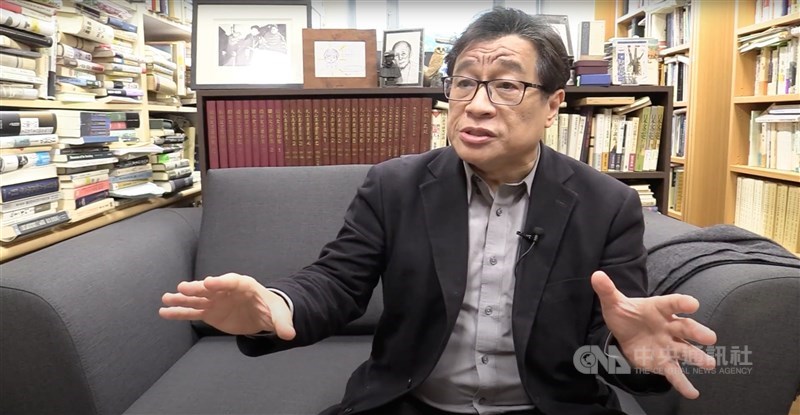
Academic Sinica Associate Research Fellow Wu Rwei-ren. CNA photo Feb. 26, 2024
Wu noted that dialogue between the families of perpetrators and victims would enable the public to be better informed of the facts about 228.
Wu said that the more people know about the incident, the less likely misunderstanding and conflict will arise.
Citing the Truth and Reconciliation Commission of South Africa, he said nationwide broadcasts of discussions between perpetrators and victims, in addition to efforts to establish facts, sparked more discussion.
Wu said more work should be done to expose perpetrators, adding that this was an area that had been the “weakest link” since Taiwan began its quest for transitional justice in the 1990s.
Ordinarily, he said, work to pursue transitional justice is initiated by presidents of pro-democracy camps, as are the cases with South Africa, Germany, and Latin America.
However, in Taiwan, when former President Lee Teng-hui (李登輝), a member of the “old forces,” began taking steps toward transitional justice, he was leading an administration riddled with perpetrators.
“Obviously, he couldn’t purge his own troops and special agents, so he went for a compromise measure, to only address the victims by identifying them,” Wu said.
As to why after being in power for eight years, the DPP’s Tsai Ing-wen (蔡英文) administration has not named more perpetrators or removed the Chiang statue, Wu said many perpetrators of violence during the 228 Incident and the ensuing White Terror have died and cannot be held legally responsible for their actions.
Even so, Wu said, the government should still disclose their names and their wrongdoing, so at the very least there would be “historical justice.”
The Chiang statue, meanwhile, is a thorny issue few politicians would tackle, he said.
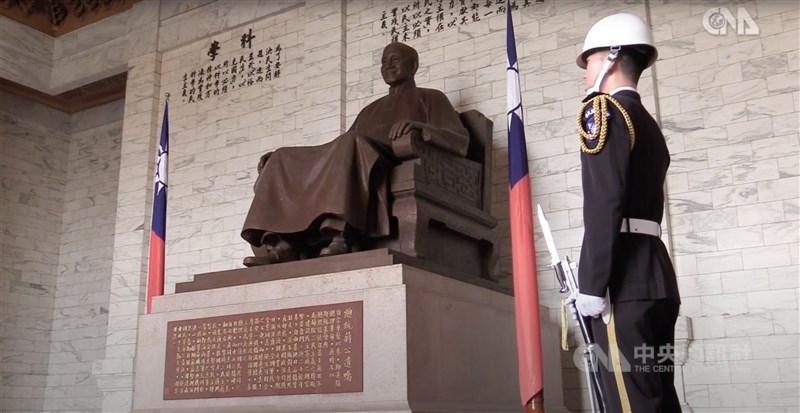
The statue of Chiang Kai-shek at Chiang Kai-shek Memorial Hall is pictured on Feb. 26, 2024. CNA photo Feb. 26, 2024
After then-Premier Su Tseng-chang (蘇貞昌) approved the dissolution of the Transitional Justice Commission in May 2022, work to promote transitional justice continues at six Cabinet-level agencies under the Transitional Justice Board convened by Premier Chen Chien-jen (陳建仁), which meets every six months.
According to the Cabinet, the board is charged with taking appropriate actions against perpetrators, declassifying political files, dealing with authoritarian symbols, as well as redressing injustices by the government or the judiciary against the people and restoring the rights of victims.
On Feb. 28 of this year, more than half of the 4,500 political files held by the government that were listed as permanently classified are set to be released, said Tseng Chien-chun (曾建鈞), a section chief at the Cabinet’s Department of Human Rights and Transitional Justice Office.
Legislative amendments passed in December 2023 revoked agencies’ right to permanently classify files, with permanently classified files to be released after 30 or 40 years in most circumstances.
DPP lawmakers hailed the amendments as being able to aid efforts to identify perpetrators of injustices from the country’s authoritarian past.
Meanwhile, work is being carried out to draw up bills to identify perpetrators in the country’s authoritarian era and to ensure the preservation of “historical sites of injustice” - sites where incidents involving mass violations of human rights took place - designated by the Transitional Justice Commission, Tseng told CNA.
As for work to “transform” Chiang Kai-shek Memorial Hall, Tseng said that a task force for this task had been created under the board, but that it had only met once, in 2023, since it was launched.
Meanwhile, Tseng said that the Ministry of Culture, tasked with the transformation of the hall, could adopt “interim measures” in the absence of legislative changes.
These include canceling the nine daily “changing of the guards” ceremonies inside the building and ridding the site of symbols idolizing Chiang so that it could be redesigned with concepts of transitional justice, Tseng said.
Guy
Can anyone access the main article?
- A recent report titled “The Truth about 228 Incident and Transitional Justice Report (Part 2)” by the February 28 Incident Memorial Foundation, led by its chairperson Hsueh Hua-yuan, has been criticized for allegedly exaggerating the number of victims.
- Independent researchers Liao Ji-bin and Zhang Ruo-tong issued a joint statement on May 8, making two major demands: firstly, to immediately remove the report from all distribution channels and libraries; secondly, to dismiss the executive director of the foundation, Lan Shi-bo.
- The February 28 Incident Memorial Foundation responded in a low-key manner, stating that all suggestions would be taken as references.
According to GPT
- General Estimates: Most historical accounts estimate that the number of victims from the incident ranges between 18,000 to 28,000 casualties. This figure is often cited in academic and historical discussions (The Diplomat).
- Government Commission Findings: A government commission set up under President Lee Teng-hui used civil registry data from the Japanese administration to determine the number of deaths. This method identified fewer numbers but did not specify an exact count in the data provided (Wikipedia).
ChatGPT’s lower number is already higher than the number in the report. Mind you, the foundation’s number is deaths in official records, not the actual number for all the victims killed as a result of 228 and subsequent military actions.